Plants
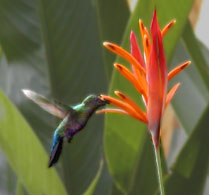 Green-throated carib visiting a
bird of paradise (Strelitzia reginae)
|
A member of the banana family, the bird of paradise is a popular ornamental plant. It is native to South Africa. Like many of the ornamental plants in the Virgin Islands, the bird of paradise was brought here for landscaping. Now many such plants can be found growing in the wild as well as in gardens.
The bird of paradise gets its name from the
unique flower that can resemble a brightly colored
bird in flight. The bird of paradise is a large plant that can grow to several feet in height. It is frequently visited by birds such as hummingbirds and bananaquits. Hummingbirds insert their long beaks into the flower to drink nectar. Bananaquits employ a different strategy: they use their short, stout beaks to poke a hole near the base of the flower to get at the nectar within.
|
The lobster claw is another relative of the banana that is a popular ornamental plant in the Virgin Islands. The colorful inflorescence of the plant emerges from large leafy shoots. Similar to the bouganvillea, the lobster claw has small flowers associated with large colorful bracts. In the pictured plant, the bracts (red and yellow structures) will continue to separate down the length of the inflorescence, then open to expose small flowers that will be pollinated by insects and birds.
|
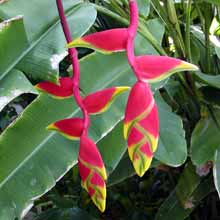 Lobster Claw (Heliconia rostratta)
|
A member of the cactus family, the night
blooming cereus blooms dramatically
at night with large, aromatic flowers.
 Night Blooming Cereus
(Selenicereus grandiflorus)
|
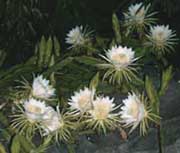 The flowers, which can be up to one foot
in diameter, last only one night and are
After pollination, the plant produces small,
red, edible fruit.
|
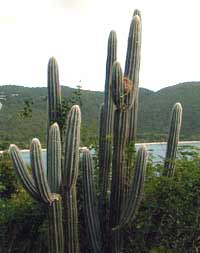 Organ Pipe Cactus (with bananaquit nest)
|
Originally from Mexico, organ pipe cactuses are tall cactuses that can be found throughout the Virgin Islands. They typically branch and send out several spine-covered stems. Birds often build nests amongst the spines for protection from predators, such as snakes and mongooses.
The plants produce a trumpet shaped flower,
then a small fruit after pollination.
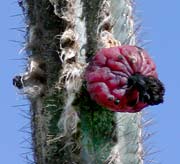 Organ Pipe Cactus (fruit)
|
Aloe is a widely cultivated and useful plant
in the Virgin Islands. It grows in sunny
areas and requires little water.
The gel-like substance that oozes from
broken aloe leaves is medicinally used to
treat everything from burns (including
sunburn) to headaches and colds.
The aloe plant is especially dramatic when
it blooms, sending up a stalk nearly three
feet in height that supports many small
yellow flowers. The nectar from these
flowers is very popular with bananaquits,
hummingbirds, and bees and other insects,
which pollinate the aloe plants.
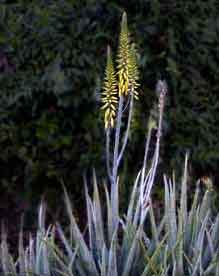 Aloe (Aloe barbadensis)
|
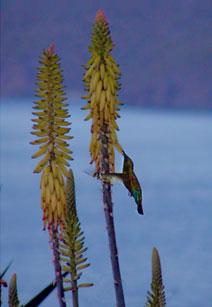 |
The bougainvillea is a common plant in the
Virgin Islands. It is popular for landscaping
and comes in many colors.
It can form sprawling mounds, extend upward
into trees, or be trimmed into hedges.
What gives the bougainvillea its striking colors
are not the petals of flowers, but modified leaves
called 'bracts'. Small flowers are nestled within
the bracts.
|
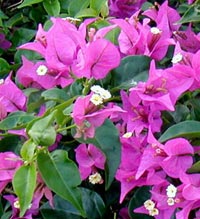 Bougainvillea
|
 Frangipani (Plumeria alba)
|
The frangipani is a beautiful plant that produces wonderfully fragrant flowers that last without wilting.
However, care must be used when handling frangipani, because the plant creates a poisonous milky sap. The sap should not be put in the mouth or rubbed around the face or eyes. One creature that makes use of the qualities of this sap is the frangipani caterpillar.
The caterpillar eats the leaves of the plant, making itself toxic and unpleasant to predators.
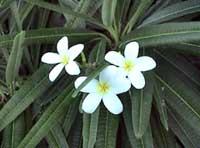 Frangipani (P. alba)
|
Hibiscus are another of the many beautiful
flowering plants found in the Virgin Islands.
Like the frangipani and bougainvillea, hibiscus
are popularly used for landscaping.
The plant has been bred to produce flowers
of various colors. The large flowers attract
pollinators such as insects and hummingbirds.
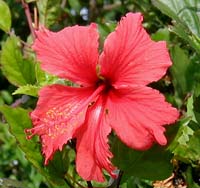 Hibiscus
(Hibiscus sp.)
|
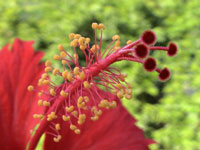 Hibiscus showing pistil and stamens
Each flower has both male (stamens) and
female (pistil) reproductive structures.
The flowers, which normally only last a
day or two, are often used to make a
refreshing drink.
|
